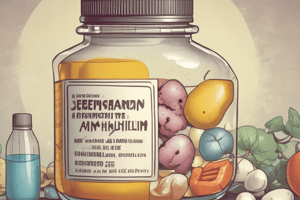Podcast
Questions and Answers
What are common therapeutic uses for cephalosporins?
What are common therapeutic uses for cephalosporins?
- Skin conditions
- Neurological disorders
- Cardiovascular diseases
- Respiratory tract infections (correct)
Which drug class is known for the mode of action involving inhibition of bacterial cell wall synthesis?
Which drug class is known for the mode of action involving inhibition of bacterial cell wall synthesis?
- Cephalosporins (correct)
- Tetracyclines
- Penicillins
- Macrolides
Which of the following is a side effect associated with cephalosporin use?
Which of the following is a side effect associated with cephalosporin use?
- Dizziness
- Nausea
- Hypotension
- Edema (correct)
What is a contraindication for the use of cephalosporins?
What is a contraindication for the use of cephalosporins?
Which of the following drug interactions decreases the effect of penicillin?
Which of the following drug interactions decreases the effect of penicillin?
Which of the following is a potential adverse reaction when using cephalosporins?
Which of the following is a potential adverse reaction when using cephalosporins?
Which cephalosporin is commonly associated with the brand name 'Ancef'?
Which cephalosporin is commonly associated with the brand name 'Ancef'?
What is a common adverse reaction associated with cephalosporins?
What is a common adverse reaction associated with cephalosporins?
What impact does dairy have on tetracycline?
What impact does dairy have on tetracycline?
Which of the following is NOT a therapeutic use of aminoglycosides?
Which of the following is NOT a therapeutic use of aminoglycosides?
What is the mode of action of aminoglycosides?
What is the mode of action of aminoglycosides?
Which side effect is commonly associated with aminoglycosides?
Which side effect is commonly associated with aminoglycosides?
Which drug-drug interaction decreases the effect of oral contraceptives?
Which drug-drug interaction decreases the effect of oral contraceptives?
Which drug class increases the effect of aspirin?
Which drug class increases the effect of aspirin?
What is a common adverse reaction to aminoglycosides?
What is a common adverse reaction to aminoglycosides?
What is a therapeutic use of macrolides?
What is a therapeutic use of macrolides?
At low doses, what is the mode of action of macrolides?
At low doses, what is the mode of action of macrolides?
Which condition is a contraindication for aminoglycoside use?
Which condition is a contraindication for aminoglycoside use?
Which of the following is a common side effect of aminoglycosides?
Which of the following is a common side effect of aminoglycosides?
Which of the following is a common side effect of macrolides?
Which of the following is a common side effect of macrolides?
What adverse reaction can occur with macrolides?
What adverse reaction can occur with macrolides?
Which condition is a contraindication for macrolides?
Which condition is a contraindication for macrolides?
How do cephalosporins interact with tetracycline?
How do cephalosporins interact with tetracycline?
Which of the following options correctly describes the effect of macrolides at high doses?
Which of the following options correctly describes the effect of macrolides at high doses?
What is the mechanism of action of glycopeptides such as vancomycin?
What is the mechanism of action of glycopeptides such as vancomycin?
Which of the following side effects is specifically associated with the use of vancomycin?
Which of the following side effects is specifically associated with the use of vancomycin?
Ketolides can be primarily used to treat which of the following conditions?
Ketolides can be primarily used to treat which of the following conditions?
Which adverse effect is common to lipopeptides like daptomycin?
Which adverse effect is common to lipopeptides like daptomycin?
What is the primary mode of action for lipopeptides such as daptomycin?
What is the primary mode of action for lipopeptides such as daptomycin?
What is a major therapeutic use of fluoroquinolones?
What is a major therapeutic use of fluoroquinolones?
What type of drugs increase the risk of ototoxicity when used with aminoglycosides?
What type of drugs increase the risk of ototoxicity when used with aminoglycosides?
What is a common side effect associated with fluoroquinolone use?
What is a common side effect associated with fluoroquinolone use?
What mechanism do fluoroquinolones use to exert their antibacterial effect?
What mechanism do fluoroquinolones use to exert their antibacterial effect?
In cases of severe renal disease, which drug class is contraindicated?
In cases of severe renal disease, which drug class is contraindicated?
What effect does the use of antacids have on the absorption of fluoroquinolones?
What effect does the use of antacids have on the absorption of fluoroquinolones?
Which of the following is NOT a typical adverse reaction of fluoroquinolones?
Which of the following is NOT a typical adverse reaction of fluoroquinolones?
Which effect can fluoroquinolones have on oral hypoglycemics?
Which effect can fluoroquinolones have on oral hypoglycemics?
Flashcards are hidden until you start studying
Study Notes
PENICILLIN
- Drug interactions: increases effect with aspirin, increases bleeding risk with oral anticoagulants, decreases effect with tetracycline.
CEPHALOSPORINS
- Examples include cefadroxil (Duricef), cefazolin sodium (Ancef), cephalexin (Keflex), and cefdinir (Omnicef).
- Therapeutic uses: treats respiratory tract infections, urinary tract infections, bone and joint infections, and otitis media.
- Mode of action: bactericidal effect through inhibition of bacterial cell wall synthesis.
- Side effects: rash, flushing, edema.
- Adverse reactions: superinfections, anaphylaxis, Stevens-Johnson syndrome.
- Contraindications: hypersensitivity to penicillin or cephalosporins.
- Drug interactions: increases effect with aspirin, increases bleeding with oral anticoagulants, decreases effect with tetracycline.
MACROLIDES
- Examples include azithromycin (Zithromax), clarithromycin (Biaxin), and erythromycin base (E-Mycin).
- Therapeutic uses: treats upper respiratory tract infections, gonorrhea, and skin infections.
- Mode of action: inhibits bacterial protein synthesis, exhibiting a bactericidal effect at high doses and bacteriostatic effect at low doses.
- Side effects: blurred vision, tinnitus, rash.
- Adverse reactions: superinfections, urticaria, hearing loss, angioedema, anaphylaxis, Stevens-Johnson syndrome.
- Contraindications: hypersensitivity to macrolides, hypokalemia, hypomagnesemia, hepatic dysfunction, renal dysfunction.
TETRACYCLINES
- Drug interactions: increases effect of digoxin, decreases absorption when combined with sucralfate or antacids, reduces efficacy of oral contraceptives, and dairy products lessen effect.
AMINOGLYCOSIDES
- Examples include amikacin sulfate (Amiken), gentamicin sulfate, and streptomycin sulfate (Streptomycin).
- Therapeutic uses: treats serious infections, particularly gram-negative bacteria (e.g., Pseudomonas aeruginosa), pelvic inflammatory disease, and Methicillin-resistant Staphylococcus aureus (MRSA).
- Mode of action: bactericidal effect through inhibition of bacterial protein synthesis.
- Side effects: visual disturbances, hearing loss, tinnitus, rash, photosensitivity.
- Adverse reactions: superinfections, urticaria, hypokalemia, hypomagnesemia, hyponatremia.
- Contraindications: hypersensitivity to aminoglycosides, severe renal disease.
- Drug interactions: increases risk of ototoxicity with loop diuretics, increases nephrotoxicity with amphotericin B and vancomycin; decreases serum potassium and magnesium in lab tests.
FLUOROQUINOLONES
- Examples include ciprofloxacin HCL (Cipro), levofloxacin (Levaquin), and moxifloxacin (Noroxin).
- Therapeutic uses: treats moderate to severe infections such as respiratory tract infections, renal, skin, bone, joint infections, cellulitis, pneumonia, urinary tract infections, and gonorrhea.
- Mode of action: bactericidal effect through interference with DNA gyrase enzyme.
- Side effects: blurred vision, rash, flushing, tinnitus, photosensitivity.
- Adverse reactions: superinfection, edema, anaphylaxis, hyperkalemia, peripheral neuropathy.
- Contraindications: hypersensitivity to fluoroquinolones, severe renal disease.
- Drug interactions: increases effect of oral hypoglycemics and caffeine, decreased drug absorption when taken with antacids.
MISCELLANEOUS
- Glycopeptides (Vancomycin): used for drug-resistant S. aureus (MRSA), inhibits bacterial cell wall synthesis. Side effects include fever and rash; adverse effects may cause ototoxicity and neurotoxicity.
- Ketolides: used for mild to moderate community-acquired pneumonia, inhibits protein synthesis. Side effects include blurred vision and altered taste; adverse effect may lead to hepatotoxicity.
- Lipopeptides (Daptomycin): treats complicated skin infections and endocarditis due to MRSA. Binds to bacterial membrane causing rapid depolarization, inhibiting protein synthesis. Side effects include hypotension and tingling; adverse effects may cause hypokalemia, hyperkalemia, hyperglycemia, and hypoglycemia.
Studying That Suits You
Use AI to generate personalized quizzes and flashcards to suit your learning preferences.




